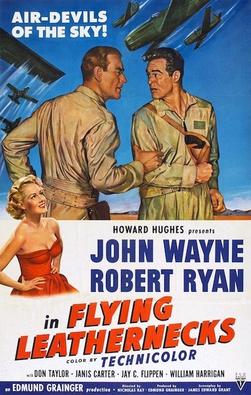
This review is best read after reading through the AAR : Intro & Coral Sea, August, September, October, November, December
Guadalcanal Campaign by Gary Grigsby, published by SSI
First release : July 1982 on Apple II
Tested on : Apple emulator
Total time tested : 20 hours
Average duration of a campaign: 15 hours
Complexity: Easy (1/5)
Would recommend to a modern player : No
Would recommend to a designer : No
Final Rating: Obsolete
The existence of Guadalcanal Campaign, and really Gary Grigsby’s entire video game career, may not have been if not for a cancelled dentist appointment. Grigsby took up to wargaming in the 70s, playing exclusively against his friend Allyn Nevitt, a naval historian who specialised in the destroyers of the Japanese Navy. The two sparring partners had full-time jobs, and wargames are time-consuming, so most of Grigsby’s wargaming activity was studying and comparing different systems and orders of battle.
In 1979, Grigsby bought a TRS-80 with the purpose of making wargames. He made a few functional ones (never published, and now lost), but was not happy with the limitations of the TRS-80 and upgraded to the Apple II in 1981. At this moment in their gaming history, Nevitt and Grigsby were frustrated at the wasted potential of SPI’s Solomons Campaign. The game had everything : sea, air, and land, but it was ruined by “confusing rules and tedious bookkeeping“. A computer, certainly, could manage these. Throughout the year, Grigsby bounced ideas with Nevitt, his “sole source of research for the project” and imagined what would be the ruleset for such a game. Finally, in December, he got to work : “it took roughly a week to write the program out on paper, a week to exhaustively research the forces involved, a week to punch the programs and data into the computer and a week to make it all (sort of) work.”
Guadalcanal Campaign was at that point a fun two-player game that Grigsby had no intention to make public. In February 1982, Grigsby took a day off to see his dentist. The dentist cancelled the appointment, so Grigsby ended up killing time by browsing through the wares of a local video game shop, picking Torpedo Fire for $60. It will surprise absolutely no one (and particularly if you read my review of Torpedo Fire) to know that Gary Grigsby had some issues with the game, and he called SSI to solve them. SSI was not a giant, and the founder and CEO Joel Billings was manning the hotline. The issue got – apparently – solved. Then, because life all comes down to a few moments, Gary Grigsby ventured : “by the way, I design computer games” Two weeks later, he signed with SSI.
Unlike Reamy’s Galactic Gladiator, Billings did not consider the game quite ready to be released as is. He had two requests: he wanted the game to use the Apple II hi-res graphics – but eventually, that request was dropped, as there was no good way to use them. The second request, however, was non-negotiable: like every other SSI game, Guadalcanal Campaign had to be playable in solitaire. After one more week of intense work, the AI was ready. After some more rounds of playtesting, bug fixing, and other minor additions the game was finally ready in July 1982.
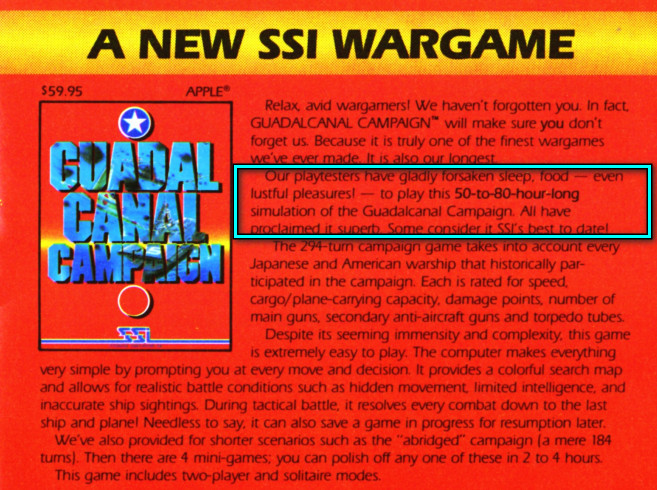
Guadalcanal Campaign was sold for $59.99, and at this price the player would receive limited extras compared to other similarly priced games: the disk, a manual, and two copies of the map. But come on, the game was 294 turns and “50-to-80-hours” long, it was well worth the price. But how does the game stack up for a modern player ?
A. Immersion
Well, there is not much to say about graphics, so let’s talk about everything else.
First, the order of battle is incredibly detailed, with each individual ship having its own stats (similar stats for ships of the same classes, of course). There is a lot of chrome, like some cruiser types having more seaplanes than others, or the special rules for the Yamato guns. And come on, again, when was the last time you saw a seaplane tender in a game that was not Rule the Waves ?
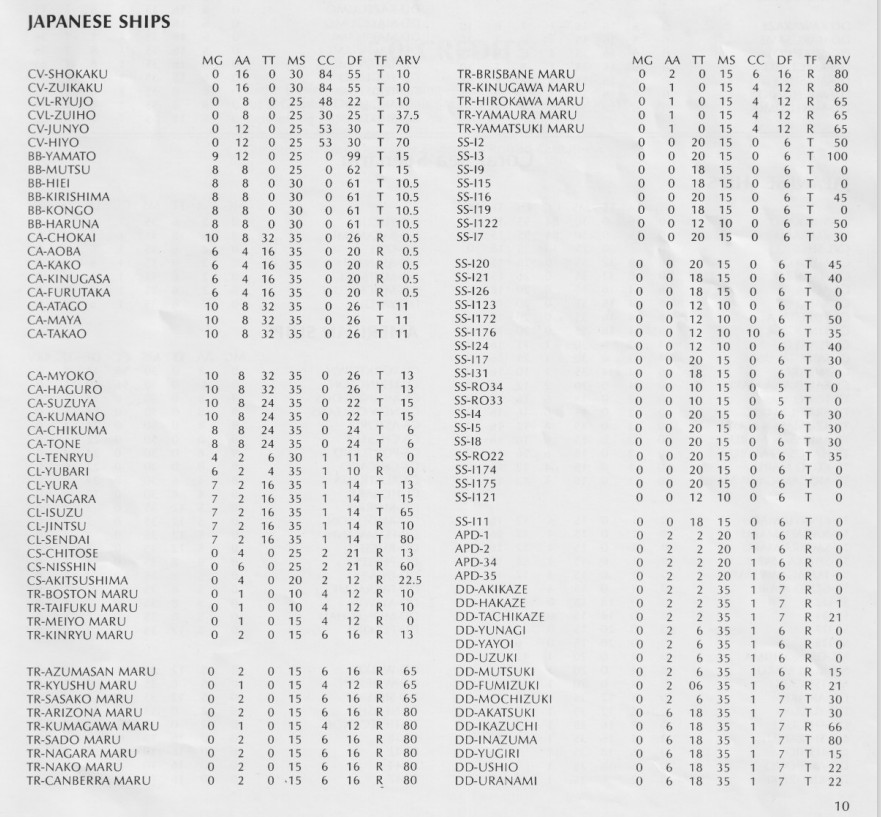
There are fewer plane types in the game (in particular P-39s, which were very active from Henderson Field, are missing), but still 10 of them, including two only used in the Coral Sea scenario (the G3M Nell and the Devastator).
As I will explain, there are plenty of individual details that are not realistic in Guadalcanal Campaign (interception with surface fleets being almost impossible outside of Guadalcanal, endurance management, scout planes can’t be shot down, performance of the Bettys and the Fortresses, performance of destroyers against submarines), some of them really irritated me, but the general ebb and flow of the campaign feels realistic – the final result of the campaign could have happened.
Something I feel I have to mention : the game downplays the role of the Commonwealth forces : British, New Zealanders and Australians – though their ships are definitely in-game.
Rating : Good
B. UI , Clarity of rules and outcomes
Writing the manual was, according to Grigsby, an excruciating effort: “Writing the rules to GC was two weeks of sheer drudgery and the undisputed low point of the whole project.” Yet, the result is one of the clearest manuals I have read so far. The description of the rules has just the right amount of detail, not drowning you in the exact calculation for this or that action, but telling you what factors have an impact on the outcome of any action.
This striving for clarity carries on in the game ; the player’s inputs in the game are organized in phases, making it very easy to follow :
- The Task Force phase
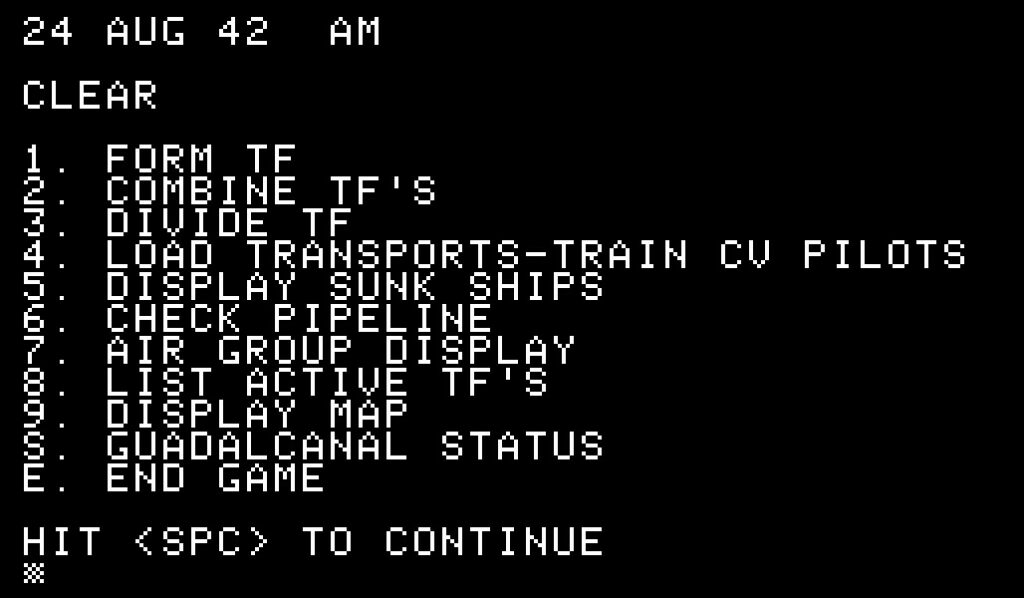
In this phase, the player can form up to 7 task forces and choose their missions :
- Combat (both surface and carrier) : A fleet will only engage another in surface combat if in “combat” mission. It is also the only mission available to carriers, even though you really don’t want them in surface combat,
- Bombardment : Only used by the Japanese in my AAR, it allows battleships and cruisers to bombard Guadalcanal. Once the bombardment is complete, the mission is converted to a Return mission,
- Transport : It is not the only mission that allows to transport troops and supplies, but it is the only mission available to transport ships. For transport destroyers, you will be better-off with Combat missions,
- Submarine : Only submarines can take this mission, and that’s the only missions submarines can take.
There are also Fast variants of missions, if all ships in the group have a speed of 30 knots or more. Those Fast missions move quicker on the map, but have much less fuel/endurance (<10), in addition to some pretty specific rules if they are ever engaged in combat.
Allocating ships to a task force, splitting ships or even loading transports all use a very similar UI : each ship has a numberID that the player must type, but happily enough the numberID of all available ships for the action is displayed. It can be a bit cumbersome for large group of 20+ ships, but I don’t see a better solution without mouse and drag & drop.
At the end of this phase, during day turns and if you have enough men and supplies, the game will also ask you if your infantry attacks the other side in Guadalcanal, and if so how much risk you’d like to take in the attack (from 1 to 5).
2. The movement phase
Every task force receives 1 movement point per 2.5 knots of speed of its slowest ship, up to 10 movement points for a normal mission and 12 movement points for a fast mission. Moving horizontally costs 2 movement points, moving in diagonals costs 3.
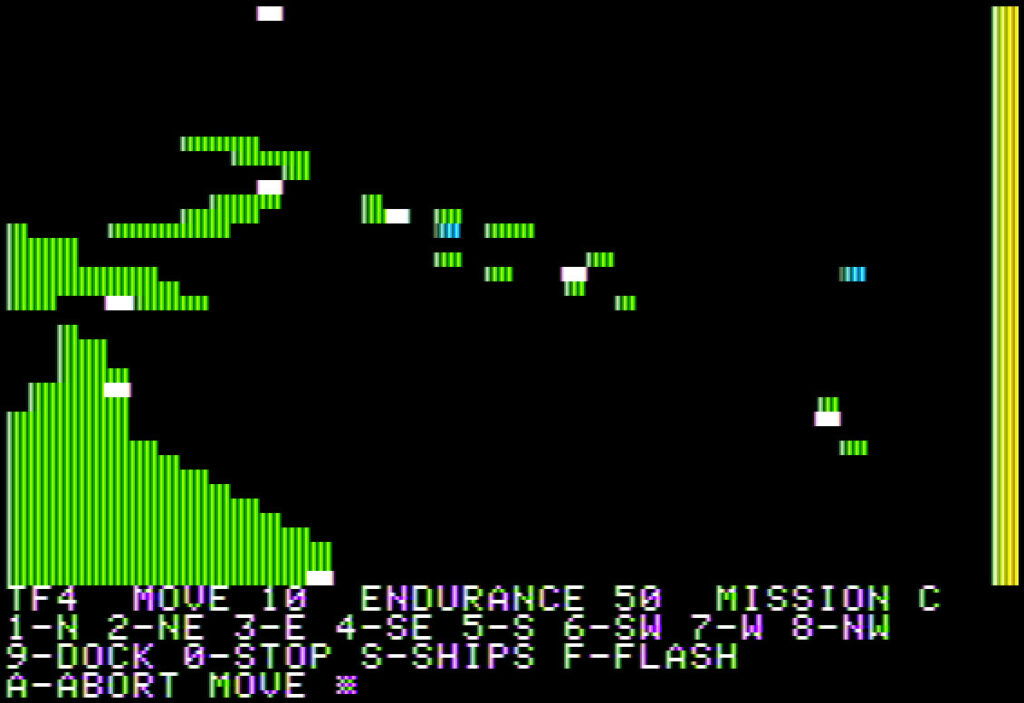
Once again, the UI is well-designed, with all the controls displayed at the bottom of the screen, including a way to abort and restart the movement if something goes wrong – an option too rare in those early wargames.
But this screen also is the source of my only frustration with the game’s UI. Submarines are slow (they have between 3 and 6 movement points), and yet since they don’t have infinite fuel you must rotate them between their area of operation and Brisbane every turn, and that’s a LONG time spent moving them, especially since their impact is secondary. A “move to” option (for submarines but also transports or crippled ships heading home), similar to what you can find in Empire would have made this phase a lot less tiresome.
3. The plane allocation phase
The player first chooses how many of their planes they allocate to :
- Combat Air Patrol (protecting the task force) – fighters only,
- Long Range Combat Air Patrol (protecting everything up to 5 tiles aways, with decreased efficiency as the distance increases) – fighters only
- Surface Search – bombers only,
- Submarine Search – bombers only ,
Any planes sent used during this phase will not be available for attack or transfer,
After seeing the result of the search (a screen in which you can call each individual enemy fleet to check its composition), the player chooses how many planes to send in strike missions, but also whether a counter-strike should be prepared (i.e. putting your planes on deck so they counter-attack against any force striking you, something I never did in the campaign) or whether to transfer to another base.
As usual, the game allows you to change orders before confirming them if you’ve made a mistake.
4. The combat resolution phase
That’s the final stressful part of the game. Airstrikes, surface combats and submarine attacks are solved in that order, as endlessly scrolling texts telling you what happened. It is clear enough, and in general you can have a recap of what happened to your ship by checking your status the following turn. It ends with the result of infantry combat in Guadalcanal, if any.
In a nutshell, Guadalcanal Campaign really has some of the best UI available before the mouse changed the rules of the game. It is extremely accessible, a far cry from Grigsby’s more recent games, as complex as they are deep – looking at you War in the East, though in fairness I read that the second opus is significantly more accessible.
Rating : Excellent
C. Systems
In general, the way the game works should be clear from the AAR and the UI description, but let’s discuss a few items of note :
- Task Force endurance
This is one of the most frustrating features. Each task force gets allocated some endurance at creation : 80 for submarines, 60 for normal missions, 6 for fast missions. A task force consumes 1 endurance by turn by just existing.
As long as a task force has at least 9 in endurance, it is fully functional. At 8 endurance and below, ships in a normal combat mission will not engage other surface fleets in combat. At 0 endurance, carriers can’t send planes, submarines can’t launch torpedoes and the max speed of every single ship is 5 knots.
Having all ships in a fleet share the same endurance is a simplification I can get behind, what I like much less are all the other rules :
- Any fleet under air attack (except by B-17) automatically drops to exactly 10 Endurance if it had more than 10, no effect otherwise. No comment needed…
- Any fleet in a significant surface combat is likely (there is some randomness involved) to drop to 8 Endurance,
The first rule in particular makes entering the area in range of Rabaul very costly : the Bettys will attack, be totally ineffective but drain the endurance of the ships, which will have to head for Brisbane for a one-week refuel. It is arbitrary, and really stops you from having fun with your carriers – since the area around Rabaul is where the Japanese are. The game loses points on that rule alone.
2. Search fleets
Overall, I feel that searches are too easy. First, scout planes cannot be shot down, so you will easily detect planes well into the Japanese area of influence. Moreover, in addition to the planes you personally send :
- each base sends 10 floatplanes,
- each cruiser & each battleship send 1 floatplane,
- each seaplane tender (plus the Japanese cruisers Tone and Chikuma – I really appreciate this kind of attention to details) sends 3 floatplanes.
This means that by default and on a clear day, with floatplanes alone, you have 67% chance to find an enemy fleet 8 tiles from Guadalcanal, which is where enemy fleets on their way to Guadalcanal usually end their day turns.
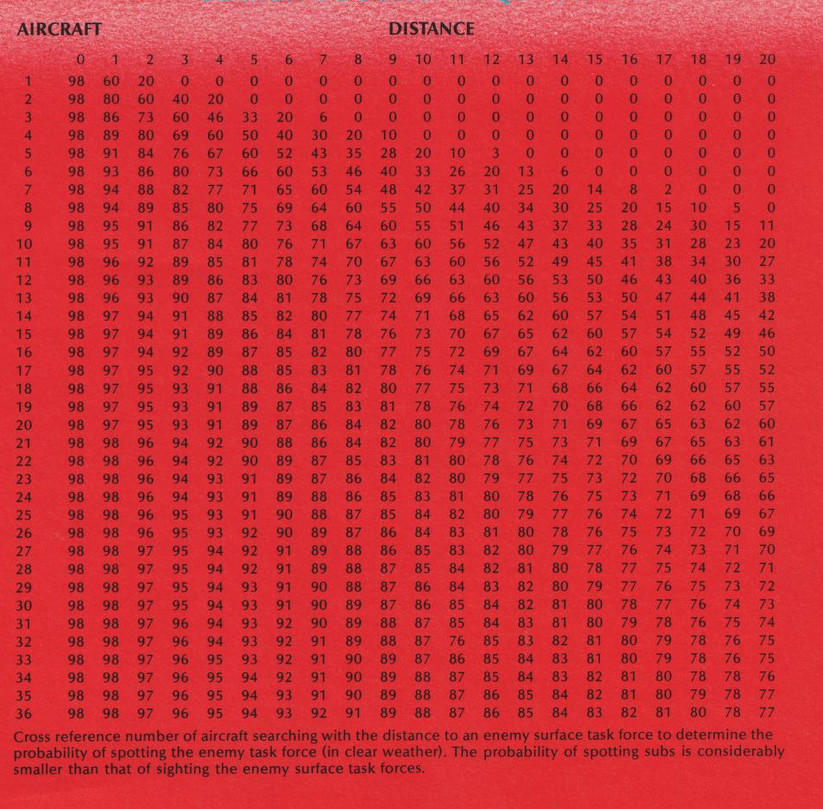
I am also sad that you cannot in any way direct your search in a specific area, or at least increase your detection chance of a fleet you have detected the previous turn (“we know it is somewhere“). Of course, due to how the turns are split, enemy fleets can cross a lot of distance between two detection attempts : you can only search during the day, once, so enemy fleets can have a full day of hidden movement, whereas in reality you would search the enemy fleets in the morning, lose them during the night, so the enemy fleets would have only one night of hidden movement.
Final point of irritation: you don’t have information about the direction of enemy fleets either, and in the case of those Tokyo Express it is hard to know whether the ships are going in or coming back.
3. Air Strike
Each fighter flying a CAP mission is allocated one of the attacking planes, and then there is a chance that either the fighter or its target is shot down. An unescorted group of bombers intercepted by a group of fighters of similar size is going to lose one-third of its number, except Bettys who will lose more than half their number :
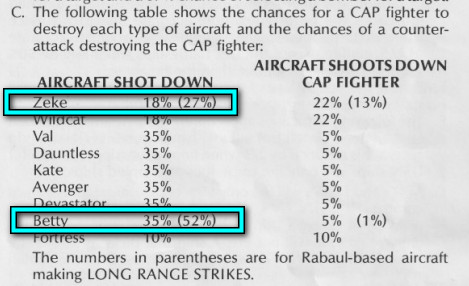
As I explained in my AAR, each strike force will have to go through each CAP group even if they took off from carriers in the same task force. It gives a powerful advantage to the Americans (with larger aircraft carriers) and makes the smallest Japanese aircraft carrier (the Zuihō) almost useless in carrier-vs-carrier strikes. If I was playing the Japanese, I would keep the Zuihō in the back to train new pilots, or make her a fighter-only aircraft carrier, 100% dedicated to CAP missions.
Also, airstrikes are solved at the same time, so you will never catch the planes on deck or refuelling as it happened historically at Midway, except if your opponent chose to keep planes in reserve for a “counter-strike”, something the AI does not do and that you should not do either.
For the record, the surviving bombers are then allocated to ships by “groups” of 10, and each ship’s odds of being targeted is a variable of its size and 10 times their carrying capacity (so transports and carriers are very likely targets). US AA is moderately effective at shooting attacking airplanes, Japanese AA even less so (as per the manual, 50% as effective) ; the main advantage of AA is that the more there are, the less likely the bombers are to hit something.
4. Surface Combat
Surface Combat can be puzzling due to its weird initiative system: the Americans if in “Combat” mission will shoot first, but even the sunk Japanese ships get to shoot back as long as their weapons weren’t destroyed too. By day, Japanese torpedo accuracy is decreased by 67%, but then I never got to fight the Japanese by day.
This is realistic, and explained by the incredible range of the Japanese Type 93 torpedoes – 20 km. The Americans did not believe such a range was possible, so they approached their ships a bit too much in combat.
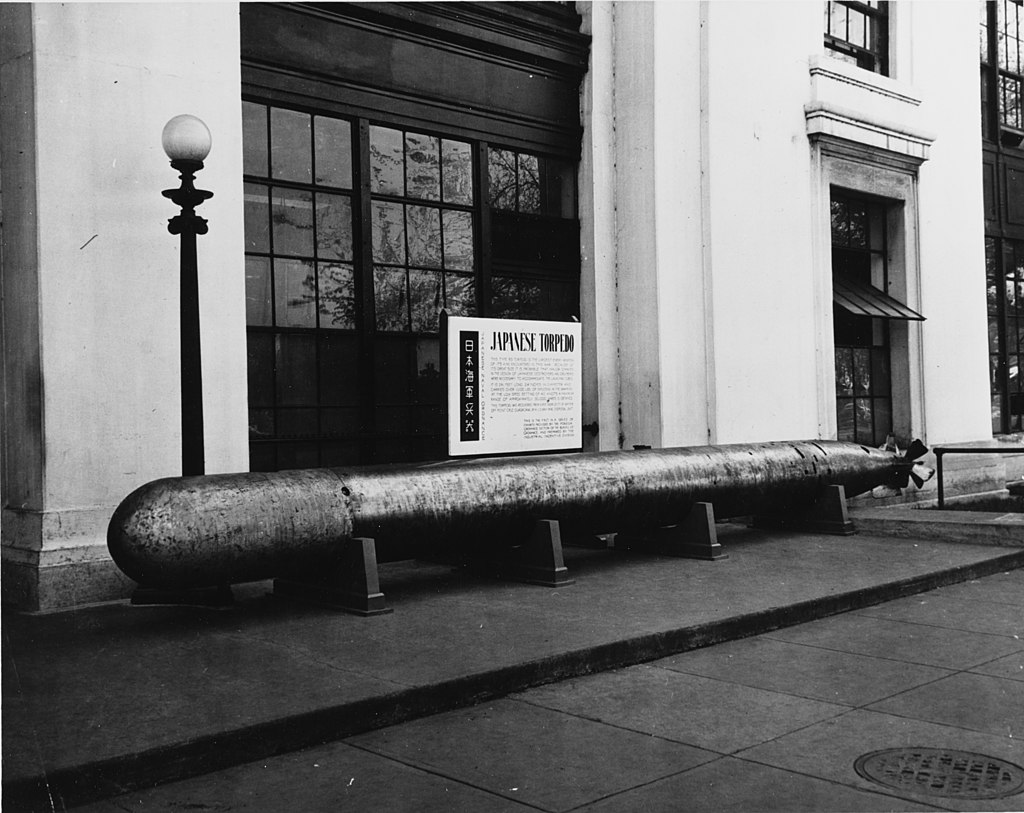
Type 93 torpedoes are really devastating in the game, dealing as much damage as the Yamato AND slowing down your ships significantly :
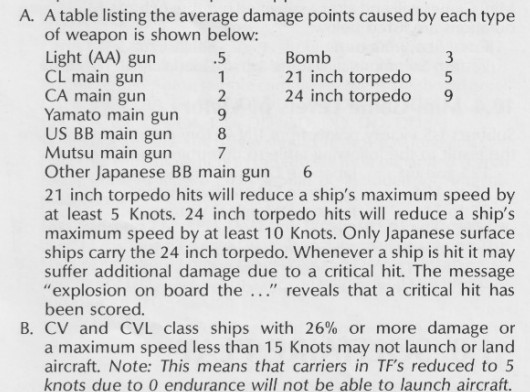
Long story short, never ever engage the Japanese in surface combat by night.
Rating : Interesting – it is really brought down by the endurance “issue” and the simplification on airstrikes and scouting.
D. Scenario design & Balancing
The game includes 6 scenarios :

- Two are so short they are basically a long roll of a die (Santa Cruz, Eastern Solomons),
- Two are more interesting, and let you try some tactics, but of course you know what the enemy has and exactly where it is going (Coral Sea, Guadalcanal),
- Two are what the game is really about : the long campaign and the short campaign. Without having played it, I suspect the short offers the same experience, only more condensed – so overall a better experience. The short campaign was actually an addition requested by Joel Billings, so probably a good call here.
But the design of the long campaigns, combined with the ruleset, creates a huge problem : there are a lot of long, boring turns where nothing happens, for a few turns of action. Of course, this is a conundrum for anyone designing a naval simulation: if the player knows what and where the enemy is, then your game is packed with action but it does not accurately represent naval warfare; if on the other hand, you have long campaigns where the player does not know what are the plans of the other side, then there will be many turns that will just be waiting. But in Guadalcanal Campaign, it is made worse by :
- the lack of automatisation (movement, scout missions), lenghtening those “waiting” turns,
- the imbalance of surface combat in favor of the Japanese, so you must rely on your carriers only,
- the endurance issue, which stops you from using your carriers agressively to intercept en route convoys,
- the fact that it takes 15 days to train new pilots, and it has to be on one of your 4 carriers,
- the lack of range of Henderson Field, which only serves as a scouting and CAP platform, but not as an attack base (unlike historically, where it flew Lockheed Hudson, and even then the other planes did intercept enemy ships as they approached), so not much fun to be had here either,
Compounding this issue, there is no real feeling of progress in the campaign : there is no strategic location to take or to defend except Guadalcanal itself, so all your forces will be allocated to this objective – your decisions become purely tactical. There are only two “situational changes” (the activation of the Cactus Air Force on the 20th of August, and the activation of Shortlands’ airbase on the 7th of October) and except for this there is almost no difference between a random day in September and random day in December, except of course the list of available ships.
Finally, there is the issue with the AI. I think it is clear from my AAR that it is not committing fully ; possibly because the transports or the carriers are hardcoded to wait for this or that damaged ship to become available. So even those turns where you have your carrier fleet around there is usually nothing to threaten it.
Stephen Van Osdell, in Computer Gaming World, analyzed the strengths and weaknesses of both sides, and concluded that the Japanese have such an advantage (magic endurance-draining Bettys, better planes, Long Lance torpedoes) that in multiplayer Guadalcanal Campaign should be played at difficulty 1 (giving the Japanese less than historical performance). But in single-player, he states that he consistently beat the AI at difficulty 3 – it is that weak.

In a nutshell, as good as the ruleset and the UI are, most of the turns are spent just waiting. I had maybe 15 turns of real action in total out of the 294 turns of the campaign.
Rating : Very poor
E. Did I make interesting decisions ?
Rarely. With only one objective (Guadalcanal), there is almost no strategic decisions to take, beyond “should I risk it”. Even when both sides have their carrier fleet sortied at the same time, carrier-vs-carrier battles are more about size of the forces and luck than any specific decision.
F. Final rating
Obsolete. Guadalcanal Campaign is a revolutionary game for sure, but also too long and repetitive.
Contemporary Reviews
Guadalcanal Campaign was one of those games destined for Computer Gaming World, and of course it was the object of its special attention. Richard Charles Karr got the privilege to pen the first review, in the September 1982 issue of CGW. Applauding the historicity of the game : “the general pulse of the game is felt : marginal American air superiority during the day and a powerful Japanese air superiority during the night.” he mentions two gripes he has with the game : naval pilots losing their naval training when transferred to an airbase, and fleets not being able to slow down to conserve fuel. Karr then offers advice, based on his 80 hours of experience playing the game (2 full campaigns, in addition to hours of initial training on the smaller scenarios) – apparently, his experience mirrors mine : he took the same “submarine avoiding” route from Espiritu Santo to Guadalcanal, he parked his carriers and submarines at the same spot and he had the same policy of avoiding dropping troops during the night. He finally concludes : “It is this writer’s opinion that Guadalcanal Campaign is the best historical simulation (and one of their best games) from SSI to date. The essential aspects of historicity and playability are well-matched, with easy accessibility of gaming information, a well-organized set of rules, and good research combining to provide for a game that will keep you at your computer for days at a time.”
Karr’s review would be followed, in the November 1982 issue of CGW, by two articles on Guadalcanal Campaign. The first article is from Grigsby himself, and I used parts of it in addition to some email exchanges to write my introduction. The second article is a discussion on the best Japanese strategy by Stephen Van Osdell ; I already mentioned it when talking about the AI. After his advice, Van Osdell can’t help but drop quite a few complaints, among which :
- B-17s should have been more accurate, and able to reach Brisbane (through New Caledonia),
- air attacks should not reduce endurance to 10,
- (again) naval pilots should not be merged with land pilots when transfered on an airbase,
- air search is a bit too easy, and should have been directional
Still, “to an avid boardgamer, this game alone can justify the purchase of a computer system”.

Guadalcanal Campaign seems to have been a success with the CGW readership (in a survey on the most important games of 1982, readers voted Guadalcanal Campaign first, with twice the score of the runner-up Choplifter). On the other hand, reviews for the game are conspicuously absent from any of the other usual English speaking magazines. One has to look at retrospectives to find mentions of the game, usually purely descriptive and high-level. One notable exception is the “Computer Game Guide” published in the December 1983 issue of the generalist GAMES Magazine. It turns out that the wargame section is written by Russel Sipe, a reviewer we have often seen on this blog: “this outstanding game is very playable despite its scale“.
In France on the other hand, the game got noticed. Casus Belli allocates two full pages to its review (their first time for a video game), though Casus Belli people being Casus Belli, a large part of said review is devoted to its weaknesses: it is slow, the AI “displays a sickening gullibility [naïveté écœurante] in its strategic planning“, the art on which “we cannot say SSI’s developers knocked themselves out.” Casus Belli insists that Guadalcanal Campaign is not the “gaming revolution” that was promised and that they expected better given the price of the game but eh, still, not bad, it is a game they recommend to “any naval conflict enthusiast“. Tilt, in its wargame retrospective in March 1984, is more positive, rating the game 5 out of 6 after a purely descriptive review.
The first monster wargame on computer, Guadalcanal Campaign sold an acceptable 4650 copies in total. Gary Grigsby would reuse the engine in two more games of increasing complexity : Bomb Alley and North Atlantic 1986, and they seem to require a lot more strategic decisions, so expect more of these long campaigns soon.
On another topic, I will soon be covering Roger Keating’s Germany ’85. It is based on Southern Command‘s engine and you can play either NATO or USSR. Which side would you prefer to see me playing in the AAR : NATO (fun part : “air cavalry”, in reality attack helicopters) or USSR (fun parts : paratroopers, initial air superiority and better songs) ?